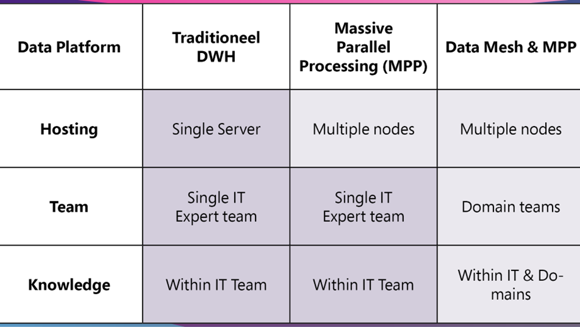Ontdek meer
Van onze Data & AI experts
Data mesh, een hot topic in de wereld van dataplatforms en Azure.
Data mesh is hot. Begrijpelijk, aangezien data mesh dé oplossing biedt voor een langdurig probleem: de schaalbaarheid van dataplatforms. Kan data mesh ook binnen jouw organisatie doorbreken? In deze blog leg ik uit wat de belangrijkste voordelen en uitdagingen zijn van een data mesh-architectuur.
De term data mesh werd geïntroduceerd door ThoughtWorks-consultant Zhamak Dehghani. Het is een architectuur waarin gedistribueerde dataproducten worden ontwikkeld en beheerd door data-engineers en data-producteigenaren in domeinteams. Een gedeelde infrastructuur wordt gebruikt om data te hosten, voor te bereiden en aan te bieden. Nu centrale datateams massaal erkennen dat ze tegen grenzen aanlopen, is data mesh een belangrijke trend geworden in de wereld van dataplatforms. Hoe is deze situatie ontstaan?
In de jaren 80 ontstond het datawarehouse: een centraal data-omgeving om rapportages uit te voeren. Het was het antwoord op de vraag hoe je een totaalbeeld krijgt van de staat van een organisatie. Deze centralisatie bracht op haar beurt nieuwe uitdagingen met zich mee, bijvoorbeeld op het gebied van technologie, kennis en personeelsbezetting. Dit leidde uiteindelijk tot de logische consequentie van een steeds groter wordend dataplatform, een steeds grotere server en een steeds groter team.
Een oplossing voor de technische uitdaging kwam rond het jaar 2000: parallelle verwerking, onder andere op het Hadoop-ecosysteem. Voor de opkomst van parallelle verwerking was de meest gebruikelijke oplossing voor prestatieproblemen het gebruik van een grotere server: schaling omhoog. Met de opkomst van parallelle verwerking konden meerdere servers worden ingezet om het dataplatform te hosten: schaling naar buiten.
Het hebben van een datawarehouse en parallelle verwerking lost het schaalbaarheidsprobleem voor kennis en personeel nog steeds niet op. Een groter dataplatform vereist nog steeds een groter centraal team met centraal verzamelde data-engineeringkennis: schaling omhoog. Daarom worden er vaak verticale splitsingen gemaakt in IT-omgevingen, waarbij data-engineers en data-analisten in verschillende teams werken. Het nadeel van deze splitsing is dat voor elk data product verschillende teams nodig zijn.
Het grote voordeel van data mesh is dat het een volwaardige oplossing voor schaalvergroting biedt.
Het splitsen van het centrale datateam en de kennis daaromheen in domeinteams, elk met hun eigen expertise. Dit stelt domeinteams in staat om optimaal zakelijk waarde te leveren binnen hun eigen vakgebied. Met de juiste standaarden, tools en kennis kunnen domeinteams zelf dataproducten leveren en deze centraal aanbieden.
• Het domeinteam beheert de datakwaliteit en kan deze goed monitoren en verbeteren;
• Het domeinteam kent de juiste definities en kan deze goed toepassen en delen;
• Het domeinteam kent de datagebruikers, kan hen goed bedienen en biedt gemoedsrust.



Essentiële vragen die elke organisatie beantwoord moet hebben voordat ze data mesh implementeren zijn: Hoe (de)centraal is mijn organisatie ingericht? Wat is de grootte van mijn organisatie?
De implementatie van data mesh is alleen zinvol als de voordelen van decentralisatie opwegen tegen de investering in het opzetten van het platform en de standaarden. Daarom is data mesh een geschikte oplossing voor (met name) organisaties met meerdere divisies en/of een internationaal karakter.
Daarnaast vereist data mesh een nieuwe rol voor IT-teams, zowel in ondersteuning als in controle. De IT-teams moeten de domeinteams ondersteunen met het platform en de juiste tools. Daarnaast moeten zij de domeinteams controleren door toezicht te houden op de toepassing van uniforme standaarden.
Met meerdere domeinteams die elk hun eigen data producten leveren, is goede ondersteuning nodig op de volgende gebieden: standaarden voor de toegankelijke beschrijving van data producten, ondersteuning voor moderne tooling en begrijpelijke standaarden voor datatransformatie.
Je hebt jezelf waarschijnlijk al de vraag gesteld: hoe kan ik de controle behouden in een omgeving met meerdere onafhankelijke teams? Het antwoord: standaardisatie en beleid. Het vaststellen van standaarden zorgt ervoor dat er geen wildgroei van code en beschrijvingen ontstaat. Bij het beheren van domeinteams zijn duidelijke beleidsregels noodzakelijk: het moet niet mogelijk zijn om code of documentatie uit te brengen die niet voldoet aan de standaarden met betrekking tot naamgeving, structuur en tagging.


Data mesh in de Azure-cloud
Data mesh is geen cloudservice die je zomaar in- of uitschakelt. Het is een combinatie van de juiste aanpak met de juiste tools. Bij het optimaal toepassen van een data mesh-architectuur in de Azure-cloud, leveren de volgende diensten de maximale waarde:
Wil je meer weten over de belangrijkste voordelen en uitdagingen van data mesh binnen jouw organisatie, of direct aan de slag? Neem contact op met de Data & AI-experts van HSO, jouw betrouwbare partner in digitale transformatie!
Ontdek meer
Van onze Data & AI experts
Wij, en derde partijen, gebruiken cookies op onze website. We gebruiken cookies om statistieken bij te houden, uw voorkeuren op te slaan, maar ook voor marketingdoeleinden (bijvoorbeeld het op maat aanbieden van advertenties). Door op 'Instellingen' te klikken kunt u meer lezen over onze cookies en uw voorkeuren aanpassen. Door op 'Alles accepteren' te klikken, ga je akkoord met het gebruik van alle cookies zoals beschreven in onze privacy- en cookie policy.
Purpose
This cookie is used to store your preferences regarding cookies. The history is stored in your local storage.
Cookies
Location of Processing
European Union
Technologies Used
Cookies
Expiration date
1 year
Why required?
Required web technologies and cookies make our website technically accessible to and usable for you. This applies to essential base functionalities such as navigation on the website, correct display in your internet browser or requesting your consent. Without these web technologies and cookies our website does not work.
Purpose
These cookies are stored to keep you logged into the website.
Cookies
Location of Processing
European Union
Technologies Used
Cookies
Expiration date
1 year
Why required?
Required web technologies and cookies make our website technically accessible to and usable for you. This applies to essential base functionalities such as navigation on the website, correct display in your internet browser or requesting your consent. Without these web technologies and cookies our website does not work.
Purpose
This cookie is used to submit forms to us in a safe way.
Cookies
Location of Processing
European Union
Technologies Used
Cookies
Expiration date
1 year
Why required?
Required web technologies and cookies make our website technically accessible to and usable for you. This applies to essential base functionalities such as navigation on the website, correct display in your internet browser or requesting your consent. Without these web technologies and cookies our website does not work.
Purpose
This service provided by Google is used to load specific tags (or trackers) based on your preferences and location.
Why required?
This web technology enables us to insert tags based on your preferences. It is required but adheres to your settings and will not load any tags if you do not consent to them.
Purpose
This cookie is used to store your preferences regarding language.
Cookies
Why required?
We use your browser language to determine which language to show on our website. When you change the default language, this cookie makes sure your language preference is persistent.
Purpose
This service is used to track anonymized analytics on the HSO.com application. We find it very important that your privacy is protected. Therefore, we collect and store this data anonymously on our own servers. This cookie helps us collect data from HSO.com so that we can improve the website. Examples of this are: it allows us to track engagement by page, measuring various events like scroll-depth, time on page and clicks.
Cookie
Purpose
With your consent, this website will load Google Analytics to track behavior across the site.
Cookies
Purpose
With your consent, this website will load the Google Advertising tag which enables HSO to report user activity from HSO.com to Google. This enables HSO to track conversions and create remarketing lists based on user activity on HSO.com.
Possible cookies
Please refer to the below page for an updated view of all possible cookies that the Google Ads tag may set.
Cookie information for Google's ad products (safety.google)
Technologies Used
Cookies
Purpose
With your consent, we use IPGeoLocation to retrieve a country code based on your IP address. We use this service to be able to trigger the right web technologies for the right people.
Purpose
With your consent, we use Leadfeeder to identify companies by their IP-addresses. Leadfeeder automatically filters out all users visiting from residential IP addresses and ISPs. All visit data is aggregated on the company level.
Cookies
Purpose
With your consent, this website will load the LinkedIn Insights tag which enables us to see analytical data on website performance, allows us to build audiences, and use retargeting as an advertising technique. Learn more about LinkedIn cookies here.
Cookies
Purpose
With your consent, this website will load the Microsoft Advertising Universal Event Tracking tag which enables HSO to report user activity from HSO.com to Microsoft Advertising. HSO can then create conversion goals to specify which subset of user actions on the website qualify to be counted as conversions. Similarly, HSO can create remarketing lists based on user activity on HSO.com and Microsoft Advertising matches the list definitions with UET logged user activity to put users into those lists.
Cookies
Technologies Used
Cookies
Purpose
With your consent, this website will load the Microsoft Dynamics 365 Marketing tag which enables HSO to score leads based on your level of interaction with the website. The cookie contains no personal information, but does uniquely identify a specific browser on a specific machine. Learn more about Microsoft Dynamics 365 Marketing cookies here.
Cookies
Technologies Used
Cookies
Purpose
With your consent, we use Spotler to measures more extensive recurring website visits based on IP address and draw up a profile of a visitor.
Cookies
Technologies Used
Cookies
Purpose
With your consent, this website will show videos embedded from Vimeo.
Technologies Used
Cookies
Purpose
With your consent, this website will show videos embedded from Youtube.
Cookies
Technologies Used
Cookies
Purpose
With your consent, this website will load the Meta-pixel tag which enables us to see analytical data on website performance, allows us to build audiences, and use retargeting as an advertising technique through platforms owned by Meta, like Facebook and Instagram. Learn more about Facebook cookies here. You can adjust how ads work for you on Facebook here.
Cookies
Purpose
With your consent, we use LeadInfo to identify companies by their IP-addresses. LeadInfo automatically filters out all users visiting from residential IP addresses and ISPs. These cookies are not shared with third parties under any circumstances.
Cookies
Purpose
With your consent, we use TechTarget to identify companies by their IP address(es).
Cookies
Purpose
With your consent, we use this service provided by uMarketingSuite to run A/B tests across the HSO.com application. A/B testing (also called split testing) is comparing two versions of a web page to learn how we can improve your experience.
Purpose
With your consent, we use this service provided by uMarketingSuite to personalize pages and content across the HSO.com application. Personalization helps us to tailor the website to your specific needs, aiming to improve your experience on HSO.com.
Purpose
With your consent, we use ZoomInfo to identify companies by their IP addresses. The data collected helps us understand which companies are visiting our website, enabling us to target sales and marketing efforts more effectively.
Cookies